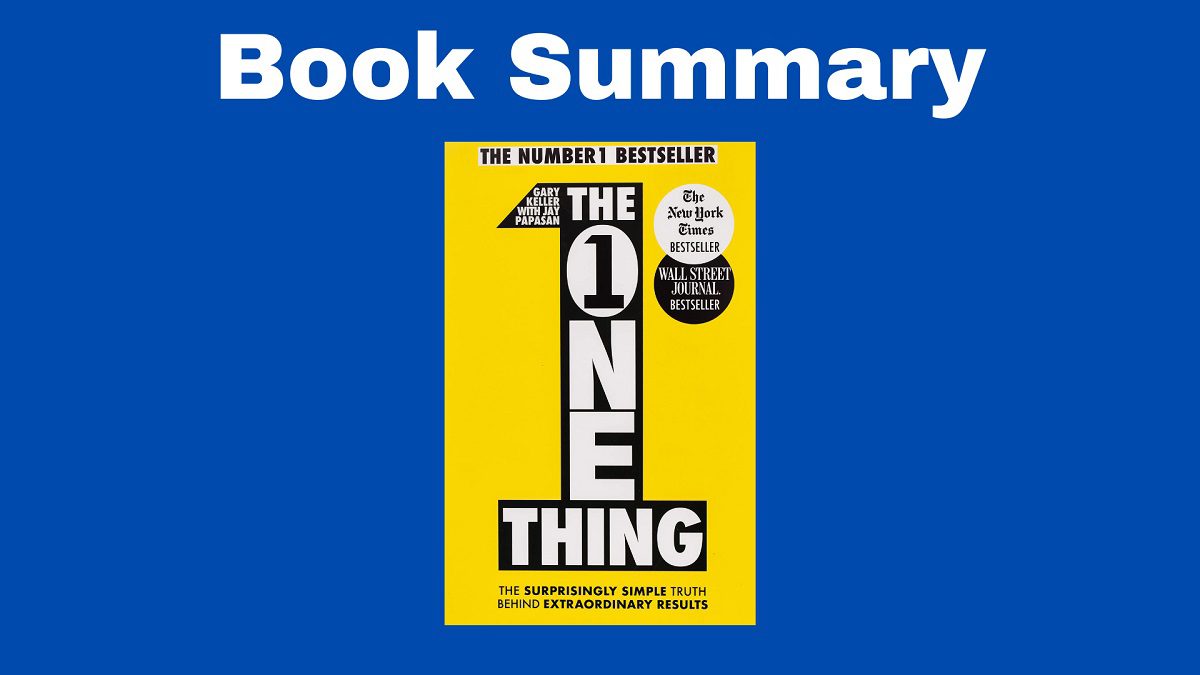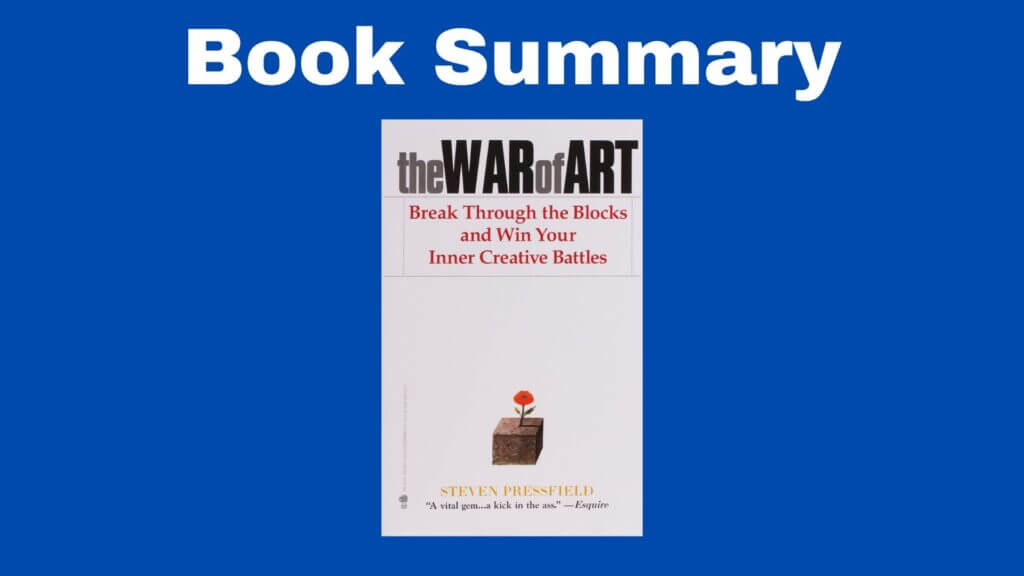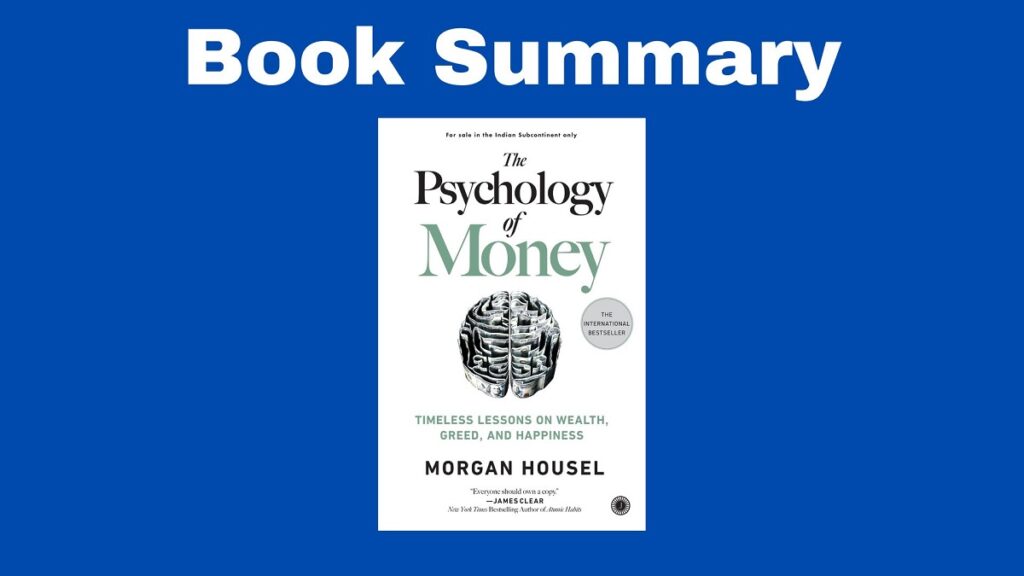The Book in Three Sentences
In this summary of The ONE Thing, you’ll learn how to have fewer distractions, be more productive, have a better income, and have more time. The ONE Thing is the most important thing in every aspect of your life. To do that, narrow your focus, do fewer things for more effect, and build success over time.
The ONE Thing Summary
Chapter 1: The ONE Thing
The secret to life is the ONE Thing, but you have to figure out what it is by yourself. By narrowing your concentration and focus to the ONE Thing, you’ll make everything easier. To do more in less time, you have to go small. This means ignoring everything you could be doing and instead, doing what you should do. Not all things matter equally. So find out the thing that matters most and narrow your focus to see extraordinary results.
Chapter 2: The Domino Effect
Through a domino effect, one domino can knock over a piece that’s 50% larger. This means you can do anything you want as long as you prioritize it and put all the energy you have into accomplishing it. Getting extraordinary results means creating your own version of the domino effect. So you need to figure out which domino to start with and topple it. This takes time, but you have to do it in a sequence and by doing one thing at a time.
Chapter 3: Success Leaves Clues
Every successful company has ONE Thing it focuses on and makes it famous. There may be other things, but there should be ONE Thing that’s more important than all the others. Similarly, for a person to be successful, there has to be someone else, such as a mentor, a helper, or an assistant. No one can succeed alone.
Part 1: The Lies
The six lies between you and success are:
- Everything matters equally
- Multitasking
- A disciplined life
- Willpower is always on will-call
- A balanced life
- Big is bad
These lies become principles and steer us in the wrong direction.
Chapter 4: Everything Matters Equally
Few things are truly equal. Everything is a choice and our lives are defined by those choices. So how do you make decisions? Doing a hundred tasks for unknown reasons doesn’t replace doing one meaningful task. By doing so, you’re focusing on being productive rather than busy. The thing that matters most should drive your day and you should say no to everything else.
We confuse the unimportant with priorities. Achievers can identify the essentials: they are able to do the things that matter first. A to-do list is a compilation of tasks you think you need to do. Instead, of a to-do list, you need a success list. While the former pulls you in different directions, the latter pulls you in a specific direction. One is disorganized and the other is organized. To-do lists are long, but success lists are short.
The Pareto principle says that a minority of causes lead to a majority of the results. In other words, the greatest results are created by fewer actions. A to-do list usually compiles a list of tasks that you could do (unessential tasks) and the ones that you should do (essential tasks). The success list, on the other hand, only focuses on the tasks that you should do. By narrowing down your to-dos to just one, you find your ONE Thing. By picking one idea from a pool of many, you’re essentially thinking big by going small.
Chapter 5: Multitasking
It’s been scientifically proven that multitasking is a lie. Multitasking isn’t efficient or effective. There’s no way to do two things at the same time and if you try, you’ll realize that won’t be able to do either of them well. When we multitask, we’re switching our attention back and forth between two things. A more apt term for multitasking would be “task switching” and it comes at a cost since it takes longer to focus when you’re alternating between two different activities. When we try to do two things at the same time, one is in the foreground and the other is in the background. By giving attention to two things, you’re giving them your “divided attention”.
Chapter 6: A Disciplined Life
A successful person isn’t necessarily disciplined. We don’t need more discipline, we just need to manage it better in order to create a habit. When you develop the right habits, your life becomes simpler. To acquire a new habit, you need an average of sixty-six days.
Chapter 7: Willpower Is Always on Will-Call
Don’t tie your success to your willpower because willpower is limited. By doing so, you’re setting up yourself for failure. Willpower and the ability to delay gratification indicate future success, but the problem is that willpower depletes over the course of the day and it replenishes with some downtime. The more we use our minds, the less mind power we have. Food also affects our willpower. We should protect our willpower and reserve it for the most important things.
Some of the things that negatively impact willpower include filtering distractions, taking tests, impressing others, and doing things you don’t enjoy. To make the most out of your willpower, do the One Thing that matters most as early as possible.
Chapter 8: A Balanced Life
Absolute balance doesn’t exist. This is idealistic and impractical. Success comes from purpose, meaning, and significance, not from balance. Time doing one thing is time spent not doing something else. This is the opposite of balance. It makes sense that we’d want balance in our lives since it sounds calm and appealing, but living in the middle prevents you from truly committing to something. Nothing magically happens when you sit comfortably in the middle. Success can be found when you venture into one of the extremes.
Time waits for no one. Postpone something and it can be permanent. Instead of seeking balance, try to find a counterbalance. So if you laser-focus on something, you’re ignoring something else. To see extraordinary results, you do what matters most. That means ignoring other things. The problem is that you can’t ignore certain things and the solution to this conundrum is counterbalancing. This means never going so far back in the opposite direction, you can’t recover. In other words, sometimes you’ll prioritize work, and other times you’ll prioritize your personal life, but you’ll never really neglect any of them.
Chapter 9: Big Is Bad
Something big doesn’t mean something hard, complicated, and time-consuming. Thinking big is essential to extraordinary results. Your thinking also determines the actions you take to get there and determines the outcomes. Big requires ambition, so you get bigger the more you work. Don’t fear thinking big, fear mediocrity.
Part 2: The Truth
Chapter 10: The Focusing Question
By asking a great question, you’ll get a great answer. The Focusing Question asks “What’s the ONE Thing I can do such that by doing it everything else will be easier or unnecessary?” The Focusing question answers everything, including the big picture (your direction in life) and the small picture (the next action you should take). The Focusing Question is all about making the best decision possible. It ignores what’s doable and focuses on what’s necessary. Every time you ask this question, you can quickly identify your next priority. The question focuses on one thing instead of many, it’s about taking action and about something with a specific purpose. By asking this question, what you have to do is doable and with little effort.
The big picture question asks: What’s my ONE Thing? The small focus question asks: What’s my ONE Thing right now?
Chapter 11: The Success Habit
The Focusing Question applies to everything in life. Approach each area in your life (financial, spiritual, business, physical health, personal, relationships) by doing what matters most in it. The Focusing Question then becomes “What can I do today for _______ such that by doing it everything else will be easier or even unnecessary?”
Chapter 12: The Path to Great Answers
The Focusing Question helps you find your ONE Thing in any area because 1) you ask a great question, and 2) you get a great answer. There are three types of answers: doable, stretch, and possibility.
- Doable: you already know how to do it. This is the most likely to be achieved.
- Stretch: you have to study to accomplish it. It’s beyond your current abilities.
- Possibility: this lies beyond what’s possible. It’s outside your comfort zone. Everything you learn from now on, you’ll use to answer the question.
Part 3: Extraordinary Results
To implement the ONE Thing, we need a rhythm that combines purpose, priority, and productivity. The big ONE Thing is your purpose and the small ONE Thing is your priority. This leads to productivity which is the only aspect that’s obvious to most people. This leads to profit. To be profitable, you have to be productive.
Chapter 13: Live with Purpose
To live an extraordinary life, you have to live with purpose, by priority, and for productivity. Purpose determines who we are and leads to happiness. Our life’s purpose can’t change because constantly changing won’t bring us happiness. To find enduring happiness, we have to enjoy the journey more than the destination. The five factors that lead to happiness are positive emotion and pleasure, achievement, relationships, engagement, and meaning. Without purpose, you’ll never know when enough is enough. Purpose gives you clarity and a sense of direction, and you’ll make good choices to get there.
Chapter 14: Live by Priority
Purpose and priority are intrinsically connected. Purpose tells where you want to go and priority tells you what to do once you get there. If something matters the most, that’s your priority. There should only be one priority. Don’t favor a small present reward over a big future reward. This is called “hyperbolic discounting”. The further away a reward is, the smaller the motivation to get it. Visualize the process and not the outcome. The outcome is far away in the future, but the process can be dealt with now. The process is all about breaking a large goal into small chunks that make sense and are clearer. Write down your goals, you’re more likely to achieve them if you do so.
Chapter 15: Live for Productivity
We’re always doing something, so make that something count. Be productive. Use a productivity system that can make you a millionaire. The most successful people are usually the most productive people. They get more done, get better results, and make more money. Successful devote their time to being productive. They protect their ONE Thing. To be highly productive, time block your ONE Thing because this gives you focus. To get disproportionate results, give disproportionate time to that activity. Those who spend a large amount of time doing their ONE Thing become accomplished, have more opportunities, and become irreplaceable.
To achieve your extraordinary results, time block these things in order:
- Time block your time off: Successful people take time out to plan their time off. Take time off (weekends and vacations) to rest and be more productive later.
- Time block your ONE Thing: This comes second. First, you rest and then, you work more relaxed. Your work shouldn’t be more time-oriented (such as finish working at 5 PM), it should be event-oriented (you’re done when you’re done). The author recommends a minimum of four hours a day to work on your ONE Thing.
- Time-block your planning time: This is the period of time you use to reflect on where you are and where you want to be. When you do something daily, momentum and motivation take over. It becomes easier.
Time blocking is simple, protecting your time block is the difficult part because the world doesn’t care about your purpose and your priorities, that’s your job. The time you’ve blocked is your most important appointment so don’t move it. Say no to everything and everyone else.
Everything other than your ONE Thing is a distraction. When something else comes up while you’re working on the ONE Thing, write it down to remember it afterward and keep working.
Here are four ideas to battle distractions:
- Build a bunker: Get an office, a do not disturb sign, a laptop with no wifi, and close the door.
- Store provisions: Have supplies and snacks so that you don’t have to leave your office unless you need a bathroom break.
- Sweep for mine: Turn off your phone, shut down your email, and remove your browser if necessary.
- Enlist support: Tell others what you’re doing and why.
Chapter 16: The Three Commitments
The three commitments to your ONE Thing are:
- Follow the path of mastery: Mastery is critical to achieving extraordinary results. Mastery is a journey, not a destination and the journey to mastery never ends. An expert isn’t gifted. He or she has practiced so much that they’ve become an elite performer. It’s not about talent, it’s about practicing over time.
- Move from “E” to “P”: Are you doing the best you can or are you doing it the best it can be done? This is the difference between being an entrepreneur (E) and being purposeful (P). When you start doing something, you soon find a ceiling of achievement. This requires a purposeful approach. When you hit that ceiling, don’t settle for it, challenge it instead. Look for new ways to do things and overcome those challenges. Never stop learning.
- Live the accountability cycle: There’s a feedback loop between what you do and what you get. You’re responsible for these. To be accountable, you have to absorb difficulties and keep going. You can be the author of your life or the victim of it. Your approach determines your actions and therefore, the outcome. To become accountable, you can find an accountability partner. Let that person be honest with you and give you objective feedback.
Chapter 17: The Four Thieves
The four thieves of productivity are:
- The inability to say no: Protect what you’ve said yes to by saying no to everyone and everything else. By saying yes to something else, you might be saying no to your ONE Thing. Don’t forget that your time and abilities are limited.
- Fear of chaos: Chaos is a natural part of the process of achieving extraordinary results. When you focus on ONE Thing, other things won’t get done which means that there will be chaos, unrest, and disorder.
- Poor health habits: Take care of your body. Don’t miss meals, eat poorly, or ignore exercise. Meditate, eat healthily, exercise, and laugh with your loved ones. Get eight hours of sleep.
- An environment that doesn’t support your goals: For you to achieve extraordinary results, the people and your surroundings must support you. They impact your attitude, health, and performance. Create a positive environment that supports your ONE Thing.
Chapter 18: The Journey
To conclude, no matter the objective, the journey involves taking one step at a time. That step is the ONE Thing. Think small and your life will be small. Thing big and your life will be big. Find your ONE Thing and live your life fully while you can.




